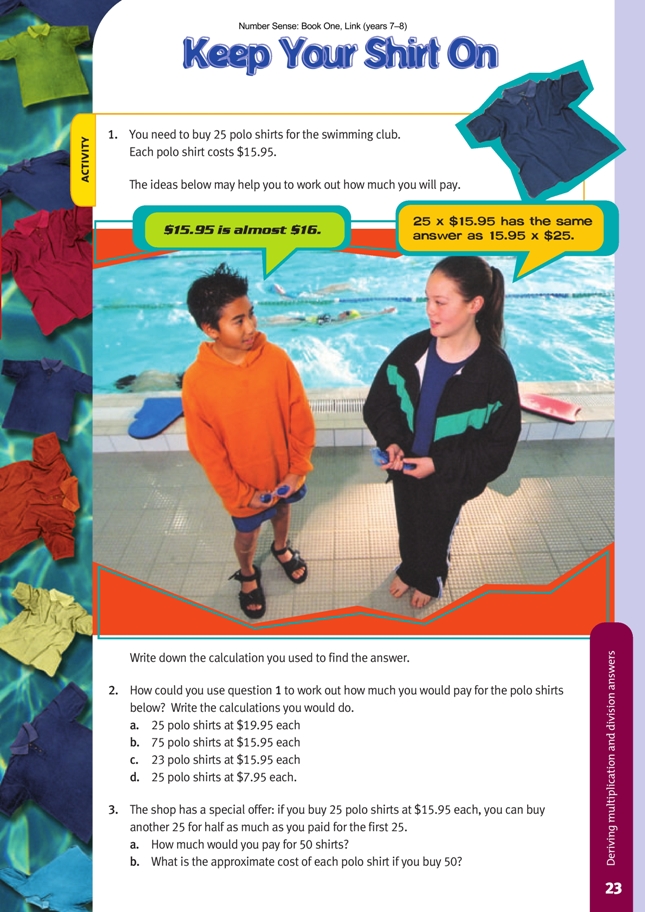This is a level 4 number activity from the Figure It Out series. It relates to Stage 7 of the Number Framework.
A PDF of the student activity is included.
Click on the image to enlarge it. Click again to close. Download PDF (637 KB)
round to the nearest whole number
use mental strategies to solve multiplication problems
This activity encourages students to use rounding to simplify the process of calculating in multiplication and division contexts.
The error caused by rounding accumulates, so it would be a good idea to display the estimated answer and then the adjusted, accurate answer to help the students develop an awareness of this fact.
Question 1 recording may look like this:
Question 2 is a great opportunity to ask the students to look for connections between question 1 and each part of question 2 to find easy ways of calculating the answers.
List the final equation for question 1 and then all the open equations for each part of question 2:
1: 25 x $15.95 = $398.75
2a: 25 x $19.95 = ?
2b: 75 x $15.95 = ?
2c: 23 x $15.95 = ?
2d: 25 x $7.95 = ?
Ask the students to look for things that are the same and things that are different between the questions. Encourage them to use these observations to find easy ways of getting a solution. For example, question 2a can be solved by adding $4 x 25 to question 1 because the shirts are $4.00 more but the same number (25) is being purchased. Question 2b is three times the answer to question 1. Question 2c is two lots of $15.95 less than question 1. Question 2d is 25 x $8 less than question 1 ($15.95 – $8.00 = $7.95). Question 3b asks for the approximate cost, so make sure that the students use rounded amounts in their calculations. The 50 shirts will cost approximately $600, so they could find the cost of one shirt by dividing
by 100 and then doubling. The equation for this is $600 ÷ 100 x 2 = $12. They could also divide by 10 and then by 5: $600 ÷ 10 = $60, then $60 ÷ 5 = $12. Alternatively, if they look at it simply as 600 ÷ 50, they may realise that they can divide both numbers by 10 and get 60 ÷ 5 = 12.
Encourage the students to report on two or three ways of thinking through the problems. Help them to form a recording model that accurately reflects the language they use.
Answers to Activity
1. Methods will vary. You could calculate your answer
like this:
16 x 25 = 4 x 100
= 400
so
15.95 x 25 = 400 – (25 x 0.05)
= 400 – 1.25
= 398.75.
2. Answers may vary. Possible methods include:
a. Take the answer to question 1 and add 25 x 4 = $100 to make up for the price increase. 398.75 + 100 = $498.75
b. Multiply the answer to question 1 by 3: 398.75 x 3 = $1,196.25
c. Take 2 x $15.95 from the answer to question 1:
398.75 – 31.90 = $366.85
d. Take 25 x 8 = $200 from the price in question 1: 398.75 – 200 = $198.75
3. a. The exact answer is $598.13. (25 x 15.95 = 398.75. Half of $398.75 is
$199.38. 398.75 + 199.38 = $598.13)
b. Approximately $12.00. (The exact answer is $11.96.) $598.13 is nearly $600.
600 ÷ 50 = 12

